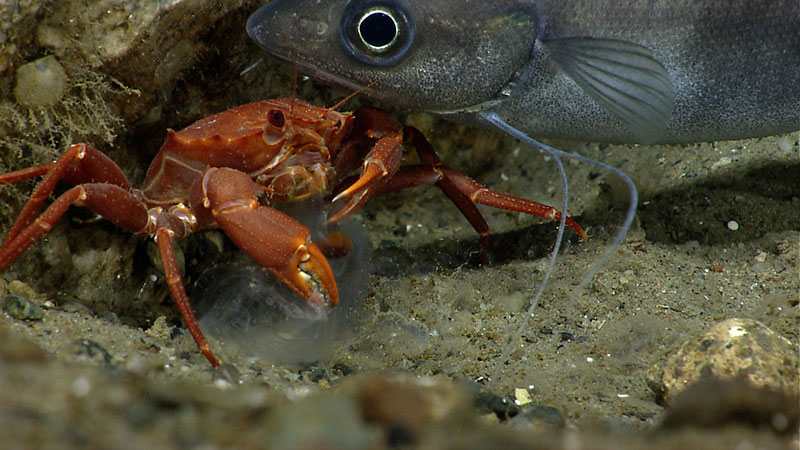
A hake interrupts a red crab while it is eating a ctenophore. Image courtesy of the NOAA Office of Ocean Exploration and Research, Northeast U.S. Canyons Expedition 2013. Download larger version (jpg, 1.4 MB).

A hake interrupts a red crab while it is eating a ctenophore. Image courtesy of the NOAA Office of Ocean Exploration and Research, Northeast U.S. Canyons Expedition 2013. Download larger version (jpg, 1.4 MB).
A catshark cruises along the seafloor during Dive 10 in an intercanyon area between Heezen and Nygren Canyons. Video courtesy of the NOAA Office of Ocean Exploration and Research, Northeast U.S. Canyons Expedition 2013. Download video (mp4, 5.5 MB).
Dive #10 was along the northeastern wall of an intercanyon area between Heezen and Nygren Canyons. The remotely operated vehicle (ROV) was on bottom at 822 meters. The dive track traversed several transition zones, allowing us to examine a suite of habitat types and diverse geological features. Specifically, the track initially transitioned from soft sediment over rocky ledges to sediment with coral rubble, then a steep slope with variegated wall structure. The wall was composed of thinly layered bedding planes, with ledges populated with various fauna, including sponges, cup corals, octocorals, colonial scleractinians, bivalves, seastars, fish, anemones, zoanthids, shrimp, and a few urchins. Iron-stained sediment was present in a few areas, sometimes associated with a yellow-white film covering the red discolored sediment, possibly microbial in origin. The ROV reached the top of the steep slope at 689 meters, and the substrate changed to a sediment field with scattered rocks of various sizes. These rocks consisted of talus type and glacial erratics (rounded stones dropped from glacial or icebergs as the melt), many with well-developed current moats or depressions around their perimeter. A majority of the rocks from 500-689 meters were colonized by encrusting sponges and anemones and associated with several mobile fauna including squat lobsters, red crabs, and a variety of fishes. Many also had small colonies of Acanthogorgia. Cancer crabs also were observed along the sediment plane at the top of the slope.
Throughout the dive, several fish species were observed, including rattails, Antimora, black dogfish, catshark, witch flounder, longfin hake, Sebastes, eelpout, ophidiidae (in cracks in wall), tonguefish, two different skates, fathead, barracudina, and black belly rose fish. At least 15 species of corals were documented during the dive, including cup corals (Javania and/or Desmophyllum), Acanella, Acanthogorgia, Anthothela, Lophelia pertusa, Primnoa, Solenosmilia?, unknown white octocoral, Paragorgia, Clavularia, white stolonifera,Paramuricea (yellow), Paramuricea cf. placomus (purple), and an unknown soft coral.
Highlights from today’s dive were the large Lophelia pertusa colonies, additional examples of predation, a new soft coral observation, and several small colonies of Acanthogorgia on rocks scattered around 500 meters. One crab trap was observed near the top of the slope (696 meters), with corals and seastars attached at the base of the trap. Fish appeared abundant and diverse, mostly present in sedimented areas, some near boulders, and others within concavities in the rock wall. Swarms of amphipods, many ctenophores, and multiple salp chains were present in the water column as the ROV traversed the sedimented plain at the top of the slope. The ROV was off bottom at 2015UTC at 498 meters.